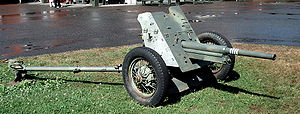45 mm anti-tank gun M1937 (53-K)
| 45 mm anti-tank gun model 1937 (53-K) | |
|---|---|

45 mm anti-tank gun M1937, displayed in Finnish Tank Museum in Parola.
|
|
| Type | Anti-tank gun |
| Place of origin | USSR |
| Production history | |
| Produced | 1937-1943 |
| No. built | 37,354 |
| Specifications | |
| Weight | combat: 560 kg (1,234 lbs) travel: 1,200 kg (2,645 lbs) |
| Length | 6.4 m |
| Barrel length | 46 calibers (2,070 mm) |
|
|
|
| Shell | 45x310 mm. R |
| Caliber | 45 mm (1.77 in) |
| Carriage | split trail |
| Elevation | -8° to 25° |
| Traverse | 60° |
| Rate of fire | 15-20 rpm |
| Muzzle velocity | 760 m/s (2,493 ft/s) |
| Maximum firing range | 4.4 km (2.73 mi) |
The 45 mm anti-tank gun model 1937 (factory designation 53-K) was a light quick-firing anti-tank gun used in the first stage of the German-Soviet War. It was created by Soviet artillery designer M.N. Loginov after the arrest and execution of former designer . Due to insufficient armor penetration it was replaced in service by the long-barreled 45 mm anti-tank gun M1942 (M-42).
The gun bearing factory designation 53-K (Cyrillic 53-К) was an improved version of 45 mm anti-tank gun M1932 (19-K) using modern ammunition. Other improvements comprised semi-automatic breech, sight, firing button, suspension, reliable shield mount, movable part re-balancing. The sum of evolutionary improvements have resulted in significantly different design to justify the new factory code (53-K).
The design was finalized 7 November 1936 and resulting light semi-automatic anti-tank gun was adopted for Red Army service in early 1937, and thus known as "45 mm anti-tank gun M1937" (Russian: 45-мм противотанковая пушка образца 1937 года). These guns were used in the first stage of the German-Soviet War, but their anti-armor capabilities allowed them to fight successfully only with German light tanks and armored personnel carriers. Early models of the Panzer III and Panzer IV could also be knocked out at close range, but this put Soviet artillerymen in greater danger. Due to these circumstances, model 1937 guns were replaced with the all-new design, the more powerful model 1942. The mass production of outdated model 1937 guns was stopped in 1943. The total number of guns produced was 37,354.
Two such guns were employed as an anti-tank platoons, organic to each rifle battalion. Additionally a dozen (12 guns) was in anti-tank battalions at a level of a rifle division. It was also used by separate anti-tank regiments (4-5 batteries of 4 guns each).
...
Wikipedia
